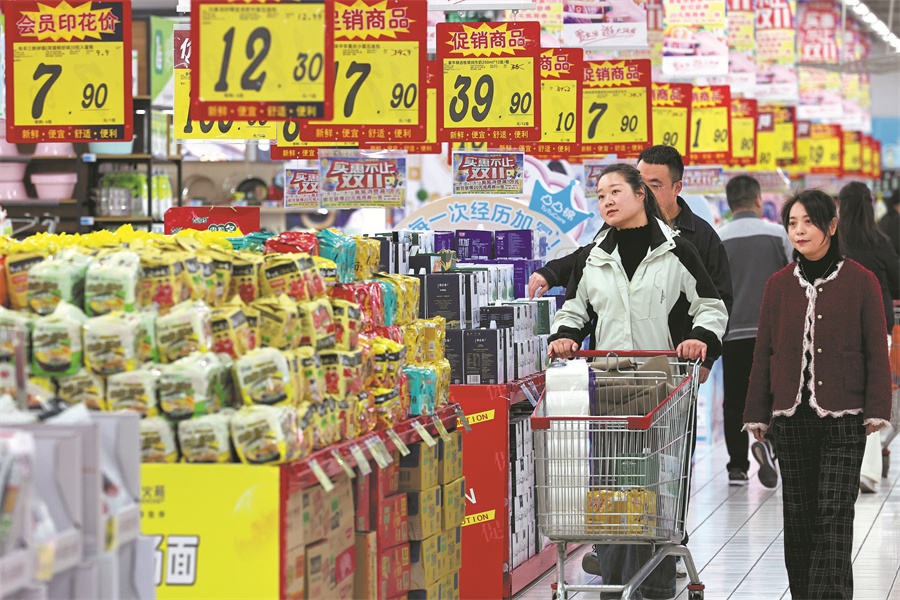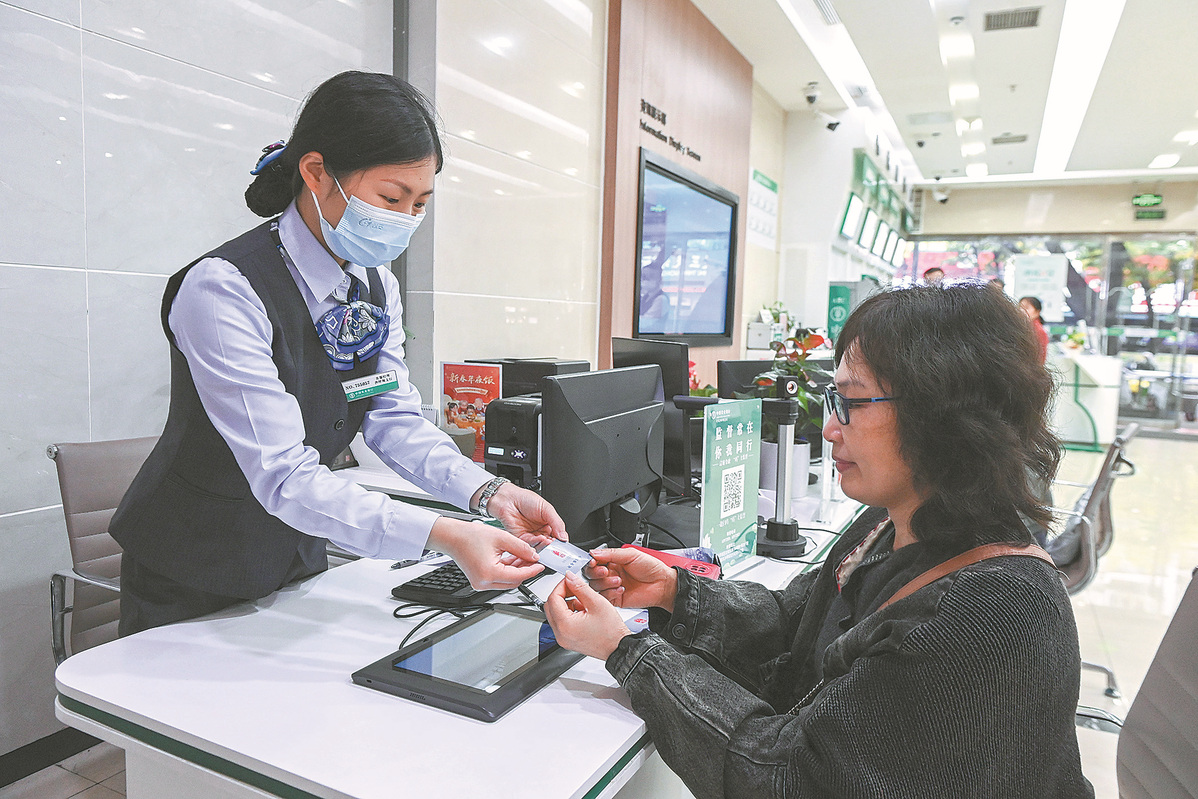Key pivot foreseen in macro strategy

Consumers shop at a supermarket in Zaozhuang, Shandong province, in November.SUN ZHONGZHE/XINHUA
China's policymakers are set to take a more proactive approach to macroeconomic policies in the year ahead, aiming to tackle both short-term challenges arising from lackluster demand and structural issues, said economists.
Citing the recently concluded Central Economic Work Conference, they said the country is fine-tuning its macroeconomic strategy, marking a significant shift toward a consumption-driven economy as it prepares for expansionary fiscal and monetary policies in 2025.
"The deficit ratio for 2025 is likely to be the highest on record," said Xiong Yuan, chief economist at Guosheng Securities, anticipating that the government would set the projected deficit-to-GDP ratio for 2025 at 3.5-4 percent or higher in March, up from 3 percent for this year.
The Chinese government started to release the annual projected deficit ratio in 2010, with the highest reading in 2020 at 3.6 percent as COVID-19 hit, according to market tracker Wind Info.
Xiong said next year's quota of special local government bonds is expected to increase to more than 4.5 trillion yuan ($616.5 billion) from a record high of 3.9 trillion yuan this year, in addition to special treasury bonds of over 2 to 3 trillion yuan in 2025, up from 1 trillion yuan for 2024.
Xiong's remarks came as the Central Economic Work Conference held in December pledged to implement more proactive and effective macroeconomic policies, boost domestic demand, drive the integration of sci-tech innovation and industrial innovation, and stabilize the real estate sector and stock markets.
The nation will maintain basic equilibrium in the balance of payments and better synchronize the income growth of households and economic expansion, according to the meeting.
"While promoting industrial sectors was the top task last year, expanding domestic demand is in the top spot this year," said Lu Ting, chief China economist at Nomura.
Lu said that the conference called for more specific measures to support consumption, including increasing basic pension payments, raising fiscal subsidies for basic medical insurance and developing policies to boost fertility.
"Overall, the conference adds support to our relatively optimistic view on fiscal policies in 2025 and our view that Beijing may stick to the 'around 5 percent' GDP growth target in 2025," he said.
According to the conference, policymakers pledged to roll out more initiatives to boost consumption, including greater strides in equipment upgrades and consumer goods trade-in programs.
Looking forward, Lu said policymakers might consider an increase in spending on social security for lower-income households and encouraging childbirth.
"We especially expect policymakers to significantly increase payments to those rural pensioners (55 percent of total pensioners) whose average monthly pension income is only 225 yuan," he said. "They may also increase financial support for families with a second or third child. And they may also waive part of the annual 400 yuan fee on basic medical insurance for low-income individuals."

A customer (right) checks social security documents at a bank branch in Chongqing in April.SUN KAIFANG/FOR CHINA DAILY
As the conference reiterated a "more proactive fiscal policy", Lu said his team forecasts a total of 3.6 trillion yuan in incremental borrowing for 2025 versus 2024, or around 2.6 percent of GDP.
"We expect the official deficit ratio to be raised from 3 percent this year to 4 percent next year," he said. "We expect net financing from central government special bonds to be raised to 1.5 trillion yuan from 1 trillion yuan in 2024."
Regarding local government special bonds, Lu said his teams expect a small increase to 4.5 trillion yuan in 2024.
Echoing the meeting of the Political Bureau of the Communist Party of China Central Committee held earlier this month, the Central Economic Work Conference statement vowed to conduct "moderately accommodative" monetary policy, switching away from a "prudent" monetary policy for the past 14 years.
"The use of words 'moderately accommodative' for monetary policy is the first time since the meeting of the Political Bureau of the CPC Central Committee in July 2010, when China was still dealing with the aftermath of the global financial crisis," Lu added. "The readout emphasizes the dual roles of aggregate and structural monetary policy instruments, leaving room for potential incremental policies from these People's Bank of China structural facilities."
The Central Economic Work Conference also promises to launch policy rate cuts and reserve requirement ratio cuts in a timely manner or whenever it is deemed appropriate, maintaining sufficient liquidity, leading the growth rate of aggregate financing and monetary supply to be mostly aligned with the expected targets of economic growth and price inflation.
"The focus on the policy rate and RRR cuts is consistent with our view, as we forecast two rounds of policy rate cuts in the first quarter and second quarter of 2025, respectively, and one 50-basis-point RRR cut before end-2024 and two 50-basis-points RRR cuts in 2025," Lu said.
With the help of a raft of government measures aimed at stimulating domestic demand and stabilizing growth in the second half of this year, China's economy showed sustained recovery with the latest economic indicators pointing to green shoots of a steady rebound heading into 2025.
Data released by the National Bureau of Statistics showed that China's value-added industrial output grew 5.4 percent year-on-year in November, up from a 5.3 percent rise in the previous month.
"This improvement reflects the impact of a series of incremental policy measures that have bolstered market confidence and supported demand recovery," said Wang Qing, chief macroeconomic analyst at Golden Credit Rating International.
Looking ahead, Wang believes that the demand for consumption and investment will continue to pick up amid a series of stimulus measures, driving strong growth in industrial production. "Industrial production growth will remain robust in December, likely in the range of 5 percent to 6 percent."
NBS data showed that the growth of retail sales slowed to 3 percent year-on-year in November from 4.8 percent in October, while fixed-asset investment saw 3.3 percent year-on-year growth during the January-November period, down from 3.4 percent in the first 10 months.
Wang said the growth rate of retail sales slowed in November, as this year's "Double 11" shopping festival presale started earlier, shifting some consumer demand from November to October.
With consumption-boosting policies taking effect gradually and the gradual improvement in consumer sentiment, Wang estimated retail sales to grow around 4.5 percent year-on-year in December.
"We anticipate that in 2025, policy measures to stimulate consumption will be further ramped up," he said.
Among these measures, Wang said the country may fund a 600 billion yuan tradein deal for consumer goods to spark household demand, and the range of subsidized products is likely to expand to include consumer electronics, home furnishings, and other durable goods.
Meanwhile, he believes fiscal support for childbirth might be piloted next year, such as one-time or monthly subsidies for families with newborns, with the support scale potentially reaching 100 billion yuan.
"There may also be a nationwide issuance of consumption vouchers and subsidies in 2025, which would expand the scope of consumption stimulation from durable goods to include general merchandise and service consumption," he said. "This reflects an important shift in the current macroeconomic policy direction, where the previous countercyclical investment policies with a key emphasis on investment are now shifting toward a more balanced approach, prioritizing both consumption and investment, with an increased focus on consumption."
